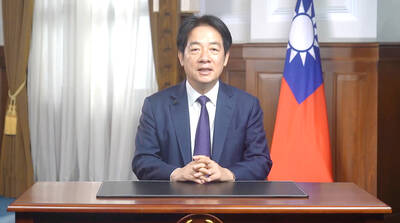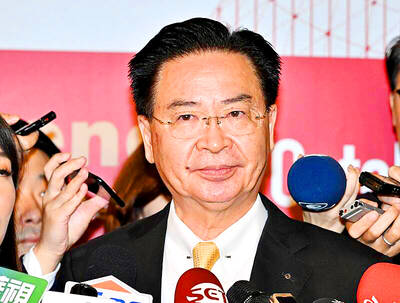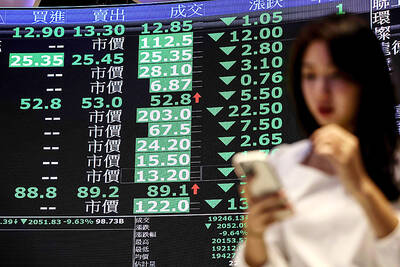The uninhabited islets in the East China Sea at the center of a bitter dispute between China and Japan are “clearly” covered by a 1960 security treaty obliging the US to come to Japan’s aid if attacked, a top US diplomat said on Thursday.
“We do not take a position on the ultimate sovereignty of these islands,” US Assistant Secretary of State for East Asian and Pacific Affairs Kurt Campbell told a US Senate Foreign Relations subcommittee.
Japan has controlled the rocky islets since 1895 — except during the 1945 to 1972 US post-World War II occupation of Okinawa — and calls them the Senkakus. China and Taiwan maintain they have an older claim and call them the Diaoyutai Islands (釣魚台).
“We do acknowledge clearly ... that Japan maintains effective administrative control ... and, as such, this falls clearly under Article 5 of the Security Treaty,” Campbell said.
He told the subcommittee that recent violent anti-Japanese demonstrations in China and other actions that stoked tensions were a growing worry to the US. The long-standing territorial dispute bubbled over again last week when the Japanese government decided to nationalize three of the islands, buying them from a private Japanese owner.
“We are concerned ... by recent demonstrations, and, frankly, the potential for the partnership between Japan and China to fray substantially in this environment,” Campbell said.
“That is not in our strategic interest and clearly would undermine the peace and stability in the Asia-Pacific [region] as a whole,” he added.
The Treaty of Mutual Cooperation and Security between the US and Japan was signed in 1960 as a successor to a 1951 bilateral security treaty and underpins what is seen as the most important of five US treaty alliances in Asia.
Article 5 says “Each Party recognizes that an armed attack against either Party in the territories under the administration of Japan would be dangerous to its own peace and safety and declares that it would act to meet the common danger in accordance with its constitutional provisions and processes.”
The article also commits the allies to report “any such armed attack and all measures taken as a result thereof” to the UN Security Council and to halt those actions once the Security Council takes steps to restore peace and security.
He said this stance on the islets is the same that has been articulated by US officials since 1997.
“The world cannot afford a crisis in Asia that would have untold consequences for our economies, and the economies of Asia, Europe and the rest of the world,” Campell told the subcommittee.
The territorial spat flared up again yesterday as a protest ship from Taiwan briefly joined around a dozen state-owned Chinese vessels in waters near the Diaoyutais, Japanese officials said.
The Taiwanese-flagged ship was spotted yesterday morning 44km off Diaoyu Island (釣魚島), or Uotsurijima, the largest island in the chain, the Japanese coast guard said.
It was the first time since early July that a protest ship from Taiwan had been seen near the islands.
In Taipei, Taiwan’s coast guard said in a statement that the vessel, the fishing boat Ta Han 711, left Keelung port late on Thursday for the islands and headed back to Taiwan before noon.
The boat, escorted by a Taiwanese coast guard vessel during the whole trip, was spotted by three Japanese boats although there was no confrontation between the two sides, the statement said.
“The coast guard will protect our people’s voluntary activities to defend the Diaoyutai islands,” it said.
The Taiwanese ship was adorned with banners reading “Protect Diaoyu” and “Get back Diaoyu,” the Japanese coast guard said.
Japan’s coast guard warned the ship “by speakers and wireless communications not to enter our territorial waters,” a spokesman for the Japanese coast guard’s Okinawa branch said by telephone.

ACTION PLAN: Taiwan would expand procurement from the US and encourage more companies to invest in the US to deepen bilateral cooperation, Lai said The government would not impose reciprocal tariffs in retaliation against US levies, President William Lai (賴清德) said yesterday, as he announced five strategies to address the issue, including pledging to increase Taiwanese companies’ investments in the US. Lai has in the past few days met with administrative and national security officials, as well as representatives from various industries, to explore countermeasures after US President Donald Trump on Wednesday last week announced a 32 percent duty on Taiwanese imports. In a video released yesterday evening, Lai said that Taiwan would not retaliate against the US with higher tariffs and Taiwanese companies’ commitments to

Intelligence agents have recorded 510,000 instances of “controversial information” being spread online by the Chinese Communist Party (CCP) so far this year, the National Security Bureau (NSB) said in a report yesterday, as it warned of artificial intelligence (AI) being employed to generate destabilizing misinformation. The bureau submitted a written report to the Legislative Yuan in preparation for National Security Bureau Director-General Tsai Ming-yen’s (蔡明彥) appearance before the Foreign Affairs and National Defense Committee today. The CCP has been using cognitive warfare to divide Taiwanese society by commenting on controversial issues such as Taiwan Semiconductor Manufacturing Co’s (TSMC, 台積電) investments in the

‘SPECIAL CHANNEL’: Taipei’s most important tasks are to stabilize industries affected by Trump’s trade tariffs and keep negotiations with Washington open, a source said National Security Council Secretary-General Joseph Wu (吳釗燮) arrived in the US for talks with US President Donald Trump’s administration, a source familiar with the matter said on Friday. Wu was leading a delegation for a meeting known as the “special channel,” the Financial Times reported earlier. It marked Trump’s first use of the channel since returning to the White House on Jan. 20. Citing a source familiar with the matter, the Financial Times reported that Minister of Foreign Affairs Lin Chia-lung (林佳龍) was also a part of the delegation. The visit came days after China concluded war games around Taiwan and amid Trump’s

HELPING HAND: The steering committee of the National Stabilization Fund is expected to hold a meeting to discuss how and when to utilize the fund to help buffer the sell-off The TAIEX plunged 2,065.87 points, or 9.7 percent, to close at 19,232.35 yesterday, the highest single-day percentage loss on record, as investors braced for US President Donald Trump’s tariffs after an extended holiday weekend. Amid the pessimistic atmosphere, 945 listed companies led by large-cap stocks — including Taiwan Semiconductor Manufacturing Co (TSMC, 台積電), Hon Hai Precision Industry Co (鴻海精密) and Largan Precision Co (大立光) — fell by the daily maximum of 10 percent at the close, Taiwan Stock Exchange data showed. The number of listed companies ending limit-down set a new record, the exchange said. The TAIEX plunged by daily maxiumu in just